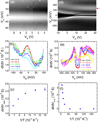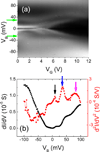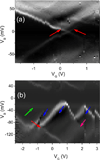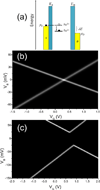An investigation into the feasibility of myoglobin-based single-electron transistors
- PMID: 22972432
- PMCID: PMC4802369
- DOI: 10.1088/0957-4484/23/39/395705
An investigation into the feasibility of myoglobin-based single-electron transistors
Abstract
Myoglobin single-electron transistors were investigated using nanometer-gap platinum electrodes fabricated by electromigration at cryogenic temperatures. Apomyoglobin (myoglobin without the heme group) was used as a reference. The results suggest single-electron transport is mediated by resonant tunneling with the electronic and vibrational levels of the heme group in a single protein. They also represent a proof-of-principle that proteins with redox centers across nanometer-gap electrodes can be utilized to fabricate single-electron transistors. The protein orientation and conformation may significantly affect the conductance of these devices. Future improvements in device reproducibility and yield will require control of these factors.
Figures








References
-
- Munier B, de Visser SP, Shaik S. Chemical Reviews. 2004;104:3947–3980. pMID: 15352783 (Preprint http://pubs.acs.org/doi/pdf/10.1021/cr020443g) URL http://pubs.acs.org/doi/abs/10.1021/cr020443g. - DOI - DOI - PubMed
-
- Marcus RA, Sutin N. Biochimica et Biophysica Acta (BBA) - Reviews on Bioenergetics. 1985;811:265–322. ISSN 0304-4173 URL http://www.sciencedirect.com/science/article/pii/030441738590014X.
-
- Bendall DS. Protein Electron Transfer. Oxford: BIOS Publishers; 1996.
-
- Tao NJ. Phys. Rev. Lett. 1996;76(21):4066–4069. URL http://link.aps.org/doi/10.1103/PhysRevLett.76.4066. - DOI - PubMed
-
- Chi Q, Farver O, Ulstrup J. Proceedings of the National Academy of Sciences of the United States of America. 2005;102:16203–16208. (Preprint http://www.pnas.org/content/102/45/16203.full.pdf+html) URL http://www.pnas.org/content/102/45/16203.abstract. - PMC - PubMed
Publication types
MeSH terms
Substances
Grants and funding
LinkOut - more resources
Full Text Sources
Miscellaneous
